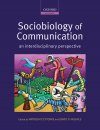Edited By: Patrizia d'Ettorre and David P Hughes
308 pages, illus, figs, tabs
![Sociobiology of Communication Sociobiology of Communication]()
Click to have a closer look
About this book
Contents
Customer reviews
Related titles
About this book
Communication is essential for all forms of social interaction from parental care, to mate choice to cooperation. This is evident for human societies but less obvious for bacterial biofilms, ant colonies or flocks of birds. The major disciplines of communication research have tried to identify common core principles, but syntheses have been few because historical barriers have limited interaction between different research fields.
Sociobiology of Communication is a timely and novel synthesis. It bridges many of the gaps between proximate and ultimate levels of analysis, between empirical model systems, and between biology and the humanities. The book offers the complementary approaches of a distinguished group of authors spanning a large diversity of research programs, addressing, for example, the genetic basis of bacterial communication, dishonest communication in insect societies, sexual selection and network communication among colonial vertebrates. Other chapters explore the role of communication in genomic conflict and self-organisation, and how linguistics, psychology and philosophy may ultimately contribute to a biological understanding of human mate choice and the evolution of human societies.
This highly interdisciplinary book highlights key examples of modern research to explore the genetic, neurobiological, physiological, chemical and behavioural basis of social communication. It identifies where consensus on the general principles is emerging and where the major future challenges are to be found. The book is therefore suitable for both for graduate students and professionals in evolutionary biology and behavioural ecology seeking novel inspiration, and for a wider academic audience, including social and medical scientists who would like to explore what evolutionary approaches can offer to their fields.
Contents
Foreword; 1. The Handicap Principle and Signalling in Collaborative Systems; 2. Communication in Bacteria; 3. Communication in Social Networks of Territorial Animals: Networking at Different Levels in Birds and Other Systems; 4. Communication between Hosts and Social Parasites; 5. Chemical Communication and the Coordination of Social Interactions in Insects; 6. Chemical Communication in Societies of Rodents; 7. Neurobiology of Olfactory Communication in the Honeybee; 8. Rapid Evolution and Sexual Signals; 9. Communication of Mate Quality in Humans; 10. The Extended Phenotype within the Colony and how it Obscurers Social Communication; 11. Synergy in Social Communication; 12. Conflicting Messages: Genomic Imprinting and Internal Communication; 13. Language Unbound:Genomic Imprinting and Psychosis in the Origin and Evolution of Modern Humans; 14. The Evolution of Human Communication and Language; 15. Why Teach? The Evolutionary Origins and Ecological Consequences of Costly Information Transfer; 16. Grades of Signalling; 17. Conclusion; Glossary
Customer Reviews
Edited By: Patrizia d'Ettorre and David P Hughes
308 pages, illus, figs, tabs
If one wants to be challenged to think outside of the box this book represents a good exercise. Michael J. Ryan TREE ...d'Ettore and Haughes have assembled a diverse selection of chapters which provide a fertile starting point for researchers, especially for those working to synthesise communication concepts across disciplines. Duncan E. Jackson Current Biology ...will allow students of animal communication to learn the language of linguists-and a new generation of scientists with broad training and rigorously defined concepts can be expected. Understanding other disciplines, and using their advances to critically examine your own premises is often the way to progress in science. Buy this book if you want to be part of that progress. Myrmecological News d




































